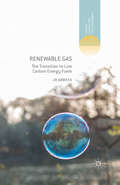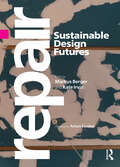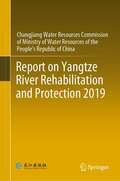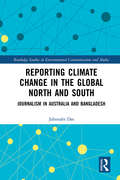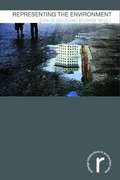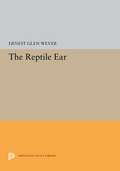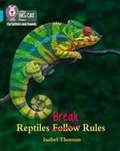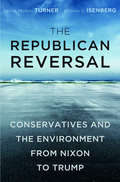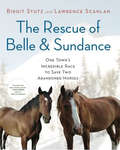- Table View
- List View
Renewable Gas: The Transition to Low Carbon Energy Fuels (Energy, Climate and the Environment)
by Jo AbbessThe author looks at the prospects for a transition from natural gas to low carbon gas, which could take several decades, and at how this will depend on the evolution of the fossil fuel industry. She investigates the technologies and energy systems for making the best use of renewable gas resources.
The Renewal of Nuclear Power in Finland (Energy, Climate and the Environment)
by M. Kojo T. LitmanenIn 2002 Finnish Parliament decided to permit further construction of nuclear power after decades of long societal struggle. This book analyzes the major phases of the decision-making process. It is an excellent guide to understanding energy and climate policy in Finland and thus the main ideas behind the renewal of nuclear power in Europe.
Renewing Local Planning to Face Climate Change in the Tropics (Green Energy and Technology)
by Maurizio Tiepolo Alessandro Pezzoli Vieri TarchianiThis book is open access under a CC BY 4.0 license. This book aims to inspire decision makers and practitioners to change their approach to climate planning in the tropics through the application of modern technologies for characterizing local climate and tracking vulnerability and risk, and using decision-making tools. Drawing on 16 case studies conducted mainly in the Caribbean, Central America, Western and Eastern Africa, and South East Asia it is shown how successful integration of traditional and modern knowledge can enhance disaster risk reduction and adaptation to climate change in the tropics. The case studies encompass both rural and urban settings and cover different scales: rural communities, cities, and regions. In addition, the book looks to the future of planning by addressing topics of major importance, including residual risk integration in local development plans, damage insurance and the potential role of climate vulnerability reduction credits. In many regions of the tropics, climate planning is growing but has still very low quality. This book identifies the weaknesses and proposes effective solutions.
Repair: Sustainable Design Futures
by Markus Berger Kate IrvinA collection of timely new scholarship, Repair: Sustainable Design Futures investigates repair as a contemporary expression of empowerment, agency, and resistance to our unmaking of the world and the environment. Repair is an act, metaphor, and foundation for opening up a dialogue about design’s role in proposing radically different social, environmental, and economic futures. Thematically expansive and richly illustrated, with over 125 visuals, this volume features an international, interdisciplinary group of contributors from across the design spectrum whose voices and artwork speak to how we might address our broken social and physical worlds. Organized around reparative thinking and practices, the book includes 30 long and short chapters, photo essays, and interviews that focus on multiple responses to fractured systems, relationships, cities, architecture, objects, and more. Repair will encourage students, academics, researchers, and practitioners in art, design and architecture practice and theory, cultural studies, environment and sustainability, to discuss, engage, and rethink the act of repair and its impact on our society and environment.
Repair: Sustainable Design Futures
by Markus Berger Kate IrvinA collection of timely new scholarship, Repair: Sustainable Design Futures investigates repair as a contemporary expression of empowerment, agency, and resistance to our unmaking of the world and the environment. Repair is an act, metaphor, and foundation for opening up a dialogue about design’s role in proposing radically different social, environmental, and economic futures. Thematically expansive and richly illustrated, with over 125 visuals, this volume features an international, interdisciplinary group of contributors from across the design spectrum whose voices and artwork speak to how we might address our broken social and physical worlds. Organized around reparative thinking and practices, the book includes 30 long and short chapters, photo essays, and interviews that focus on multiple responses to fractured systems, relationships, cities, architecture, objects, and more. Repair will encourage students, academics, researchers, and practitioners in art, design and architecture practice and theory, cultural studies, environment and sustainability, to discuss, engage, and rethink the act of repair and its impact on our society and environment.
Repairing Domestic Climate Displacement: The Peninsula Principles (Routledge Studies in Development, Displacement and Resettlement)
by Scott Leckie Chris HugginsClimate change, sometimes thought of as a problem for the future, is already impacting people’s lives around the world: families are losing their homes, lands and livelihoods as a result of sea level rise, increased frequency and intensity of storms, drought and other phenomena. Following several years of preparatory work across the globe, legal scholars, judges, UN officials and climate change experts from 11 countries came together to finalise a new normative framework aiming to strengthen the right of climate-displaced persons, households and communities. This resulted in the approval of the Peninsula Principles on Climate Displacement within States in August 2013. This book provides detailed explanations and interpretations of the Peninsula Principles and includes in-depth discussion of the legal, policy and programmatic efforts needed to uphold the standards and norms embedded in the Principles. The book provides policy-makers with the conceptual understanding necessary to ensure that national-level policies are in place to respond to the climate displacement challenge, as well as a firm sense of the programme-level approaches that can be taken to anticipate, reduce and manage climate displacement. It also provides students and policy advocates with the necessary information to debate and critique responses to climate displacement at different levels. Drawing together key thinkers in the field, this volume will be of great relevance to scholars, lawyers, legal advisors and policy-makers with an interest in climate change, environmental policy, disaster management and human rights law and policy.
Repairing Domestic Climate Displacement: The Peninsula Principles (Routledge Studies in Development, Displacement and Resettlement)
by Scott Leckie Chris HugginsClimate change, sometimes thought of as a problem for the future, is already impacting people’s lives around the world: families are losing their homes, lands and livelihoods as a result of sea level rise, increased frequency and intensity of storms, drought and other phenomena. Following several years of preparatory work across the globe, legal scholars, judges, UN officials and climate change experts from 11 countries came together to finalise a new normative framework aiming to strengthen the right of climate-displaced persons, households and communities. This resulted in the approval of the Peninsula Principles on Climate Displacement within States in August 2013. This book provides detailed explanations and interpretations of the Peninsula Principles and includes in-depth discussion of the legal, policy and programmatic efforts needed to uphold the standards and norms embedded in the Principles. The book provides policy-makers with the conceptual understanding necessary to ensure that national-level policies are in place to respond to the climate displacement challenge, as well as a firm sense of the programme-level approaches that can be taken to anticipate, reduce and manage climate displacement. It also provides students and policy advocates with the necessary information to debate and critique responses to climate displacement at different levels. Drawing together key thinkers in the field, this volume will be of great relevance to scholars, lawyers, legal advisors and policy-makers with an interest in climate change, environmental policy, disaster management and human rights law and policy.
Replenish: The Virtuous Cycle of Water and Prosperity
by Sandra PostelThe author takes readers around the world to explore water projects that work with, rather than against, nature’s rhythms. In New Mexico, forest rehabilitation is safeguarding drinking water, keeping it clear of the black sludge that raged down riverbeds in the aftermath of the Las Conchas Fire. Along the Mississippi River, farmers are planting cover crops to reduce polluted runoff while improving their yields. In China, “sponge cities” are capturing rainwater to curb urban flooding and boost water supplies.
Report on Global Environmental Competitiveness (Current Chinese Economic Report Series)
by Li Jianping Li Minrong Wang Jinnan Li Jianjian Su Hongwen Huang MaoxingThis book explores the environmental competitiveness of 133 countries around the world, presenting an index evaluation system to facilitate a comparative analysis of environmental competitiveness on a global scale. This is a new way to measure competitiveness in the light of the contradiction between world economic development and environmental protection. Global environmental competitiveness covers five aspects: the ecological environment, resources environment, environmental management, environmental impacts and environmental coordination. The authors use longitudinal study and horizontal analysis, combining qualitative and quantitative analysis methods so as to conduct an in-depth study of theoretical, empirical and methodological issues of global environmental competitiveness.The work is presented here in three main parts beginning with the theory, technical road-map and analytical approach used. The second part reports on the countries as evaluation objects, analyzing the development status of global environmental competitiveness as a whole and revealing the strengths and weaknesses of each country’s environmental competitiveness. Basic paths and strategies to enhance the competitiveness level are presented. In the third part the reader will discover a sub-report and evaluation of the environmental competitiveness for 133 countries around the world, revealing the characteristics and relative differences of countries representing different levels of development, in order to provide an important decision-making reference to those considering environmental economic policies, especially those considering accelerating a green economic transformation and enhancing environmental competitiveness.This book will appeal to scholars and professionals with an interest in environmental issues and environmental competitiveness at a global level, as well as those with an interest in each of the 133 countries analyzed in this text, including environmental policy makers in those countries.
Report on Yangtze River Rehabilitation and Protection 2019
by CWRCThis book summarizes the achievements and experience of the Yangtze River rehabilitation and protection, analyzes the new situation and requirements of the Yangtze River rehabilitation and protection, and discusses the main issues and their solution alternatives for the Yangtze River rehabilitation and protection efforts. The Yangtze River, respected as the mother river of the Chinese nation, contributes immensely toward the socioeconomic development of China and braces up the national strategies such as the development of the Yangtze River Economic Belt and the integrated development of the Yangtze River Delta, etc. Whether the Yangtze River is under good stewardship has implications on not only the wellbeing of more than 400 million inhabitants in the basin, but also in broader sense the overall sustainability of socioeconomic development of the whole country. This book which has two parts, provides a multidirectional analysis of Yangtze River rehabilitation and protection. The first part explores the stages, achievements, and the future of the Yangtze rehabilitation and protection. Major issues existing in Yangtze River Basin rehabilitation and protection are discussed in the second part. Many pictures, charts, and diagrams are involved providing an understanding of the situation of Yangtze River Basin.
Reporting Climate Change in the Global North and South: Journalism in Australia and Bangladesh (Routledge Studies in Environmental Communication and Media)
by Jahnnabi DasThis book reveals how journalists in the Global North and Global South mediate climate change by examining journalism and reporting in Australia and Bangladesh. This dual analysis presents a unique opportunity to examine the impacts of media and communication in two contrasting countries (in terms of economy, income and population size) which both face serious climate change challenges. In reporting on these challenges, journalism as a political, institutional, and cultural practice has a significant role to play. It is influential in building public knowledge and contributes to knowledge production and dialogue, however, the question of who gets to speak and who doesn’t, is a significant determinant of journalists’ capacity to establish authority and assign cultural meaning to realities. By measuring the visibility from presences and absences, the book explores the extent to which the influences are similar or different in the two countries, contrasting how journalists’ communication power conditions public thought on climate change. The investigation of climate communication across the North-South divide is especially urgent given the global commitment to reduce greenhouse gas emissions and it is critical we gain a fuller understanding of the dynamics of climate communication in low-emitting, low-income countries as much as in the high emitters, high-income countries. This book contributes to this understanding and highlights the value of a dual analysis in being ably draw out parallels, as well as divergences, which will directly assist in developing cross-national strategies to help address the mounting challenge of climate change. This book will be of great interest to students and scholars of climate change and environmental journalism, as well as media and communication studies more broadly.
Reporting Climate Change in the Global North and South: Journalism in Australia and Bangladesh (Routledge Studies in Environmental Communication and Media)
by Jahnnabi DasThis book reveals how journalists in the Global North and Global South mediate climate change by examining journalism and reporting in Australia and Bangladesh. This dual analysis presents a unique opportunity to examine the impacts of media and communication in two contrasting countries (in terms of economy, income and population size) which both face serious climate change challenges. In reporting on these challenges, journalism as a political, institutional, and cultural practice has a significant role to play. It is influential in building public knowledge and contributes to knowledge production and dialogue, however, the question of who gets to speak and who doesn’t, is a significant determinant of journalists’ capacity to establish authority and assign cultural meaning to realities. By measuring the visibility from presences and absences, the book explores the extent to which the influences are similar or different in the two countries, contrasting how journalists’ communication power conditions public thought on climate change. The investigation of climate communication across the North-South divide is especially urgent given the global commitment to reduce greenhouse gas emissions and it is critical we gain a fuller understanding of the dynamics of climate communication in low-emitting, low-income countries as much as in the high emitters, high-income countries. This book contributes to this understanding and highlights the value of a dual analysis in being ably draw out parallels, as well as divergences, which will directly assist in developing cross-national strategies to help address the mounting challenge of climate change. This book will be of great interest to students and scholars of climate change and environmental journalism, as well as media and communication studies more broadly.
Repowering Cities: Governing Climate Change Mitigation in New York City, Los Angeles, and Toronto
by Sara HughesCity governments are rapidly becoming society's problem solvers. As Sara Hughes shows, nowhere is this more evident than in New York City, Los Angeles, and Toronto, where the cities' governments are taking on the challenge of addressing climate change.Repowering Cities focuses on the specific issue of reducing urban greenhouse gas (GHG) emissions, and develops a new framework for distinguishing analytically and empirically the policy agendas city governments develop for reducing GHG emissions, the governing strategies they use to implement these agendas, and the direct and catalytic means by which they contribute to climate change mitigation. Hughes uses her framework to assess the successes and failures experienced in New York City, Los Angeles, and Toronto as those agenda-setting cities have addressed climate change. She then identifies strategies for moving from incremental to transformative change by pinpointing governing strategies able to mobilize the needed resources and actors, build participatory institutions, create capacity for climate-smart governance, and broaden coalitions for urban climate change policy.
Representing Africa: Landscape, Exploration And Empire In Southern Africa, 1780-1870 (PDF) (Studies In Imperialism Ser.)
by John McAleerSouthern Africa played a varied but vital role in Britain's maritime and imperial stories: it was one of the most intricate pieces in the British imperial strategic jigsaw, and representations of southern African landscape and maritime spaces reflect its multifaceted position. Representing Africa examines the ways in which British travellers, explorers and artists viewed southern Africa in a period of evolving and expanding British interest in the region. Drawing on a wide range of archival sources, contemporary travelogues and visual images, many of which have not previously been published in this context, this book posits landscape as a useful prism through which to view changing British attitudes towards Africa. Richly illustrated, this book will be essential reading for scholars and students interested in British, African, imperial and exploration history, art history, and landscape and environment studies.
Representing The Environment
by John Gold George RevillThe development of the environmental movement has relied heavily upon written and visual imagery. Representing the Environmentoffers an introductory guide to representations of the environment found in the media, literature, art and everyday life encounters. Featuring case studies from Europe, the Americas and Australia, Representing the Environmentprovides practical guidance on how to study environmental representations from a cultural and historic perspective, and places the reader in the role of active interpreter. The book argues that studying representations provides an important lens on the development of environmental attitudes, values and decision-making.
Reproductive Behavior and Evolution (Evolution, Development, and Organization of Behavior #1)
by J. RosenblattThe Daniel S. Lehrman Memorial Symposia Series will publish the proceedings of symposia devoted to the evolution, development, and organization of behavior. These various symposia will bring together at intervals scientists studying problems from each of these view points. The aim is to attempt to integrate our knowledge derived from these different sources and to familiarize scientists working on similar behavior patterns with the work of their colleagues in related fields of study. Each volume, therefore, will be devoted to a specific topic in the field of animal behavior, which will be explored with respect to its evolutionary aspects, including the adaptive nature of the behav ior; with respect to its developmental aspects, including neural, hor monal, and experiential influences; and with respect to the analysis of features of organization, including motivational, perceptual, and motor aspects and their physiological bases. It is our feeling that the most appropriate memorial to our colleague and close friend, Daniel S. Lehrman, is the continuation of his valuable contributions toward integrating these approaches to the study of animal behavior, which he pursued so effectively during his own life. Daniel S. Lehrman's lifelong love and study of animal behavior gave us a wealth of new insights into reproductive behavior and evolution. It is therefore appropriate that the first symposium of this series is devoted to recent advances in this field.
The Reptile Ear (Princeton Legacy Library #5348)
by Ernest Glen WeverIn this definitive work, Ernest Glen Wever establishes the evolutionary importance of the reptile ear as the origin of the higher type of auditory apparatus shared by man and the mammals. Tracing the development of the auditory receptor in the living reptiles, he examines the use of a variety of mechanisms and principles of action by that receptor. While some of the material in this book has appeared previously in journal articles, most of it is presented here for the first time.Basing this study on his twenty years of research at Princeton's Auditory Research Laboratories, Professor Wever treats in anatomical and functional detail the auditory mechanism in about 250 species and subspecies of reptiles. The anatomical treatment rests on dissections and histological examinations of the ears in serial section, and portrays the relevant features in drawings that represent particular views of reconstructions. The author evaluates the performance of thesse ears electrophysiologically, in terms of the electrical potentials of the cochlea, paying particular attention to problems of the transmission of vibrations inward to the cochlea and the actions there in stimulating the sensory cells.Professor Wever finds that the cochlea emerged independently from the non-auditory labyrinth in three different vertebrate groups: fishes, amphibians, and reptiles. It was among the reptiles, however, that the vertebrate ear took on a more advanced configuration from which it further evolved along separate lineages in the birds and mammals.Ernest Glen Wever is Eugene Higgins Professor of Psychology Emeritus at Princeton University.Originally published in 1978.The Princeton Legacy Library uses the latest print-on-demand technology to again make available previously out-of-print books from the distinguished backlist of Princeton University Press. These editions preserve the original texts of these important books while presenting them in durable paperback and hardcover editions. The goal of the Princeton Legacy Library is to vastly increase access to the rich scholarly heritage found in the thousands of books published by Princeton University Press since its founding in 1905.
Reptiles Break Rules: Band 7 Tturquoise (PDF) (Collins Big Cat Phonics For Letters And Sounds Ser.)
by Isabel ThomasCollins Big Cat Phonics for Letters and Sounds features exciting fiction and non-fiction decodable readers to enthuse and inspire children. They are fully aligned to Letters and Sounds Phases 1-6 and contain notes in the back. The Handbooks provide support in demonstration and modelling, monitoring comprehension and expanding vocabulary. Some reptiles like to surprise us and break all the rules! Discover the three-eyed reptile, the reptile that can grow a new tail and the reptile that can walk on water in this fascinating non-fiction book by Isabel Thomas. Turquoise/Band 7 books offer literary language and extended descriptions, with longer sentences and a wide range of unfamiliar terms. The focus sounds in this book are: /n/ kn, gn /m/ mb /r/ wr /s/ c, ce, sc /c/ x /zh/ sion /sh/ ti, ci Pages 22 and 23 allow children to re-visit the content of the book, supporting comprehension skills, vocabulary development and recall. Reading notes within the book provide practical support for reading Big Cat Phonics for Letters and Sounds with children, including a list of all the sounds and words that the book will cover.
The Republican Reversal: Conservatives and the Environment from Nixon to Trump
by James Morton TurnerNot long ago Republicans took pride in their tradition of environmental leadership. The GOP helped create the EPA, extend the Clean Air Act, and protect endangered species. Today Republicans denounce climate change as a “hoax” and seek to dismantle environmental regulations. What happened? James Morton Turner and Andrew C. Isenberg provide answers.
Rereading Darwin’s Origin of Species: The Hesitations of an Evolutionist (Explorations in Science and Literature)
by Richard G. Delisle James TierneyWidely seen as evolution's founding figure, Charles Darwin is taken by many evolutionists to be the first to propose a truly modern theory of evolution. Darwin's greatness, however, has obscured the man and his work, at times even to the point of distortion. Accessibly written, this book presents a more nuanced picture and invites us to discover some neglected ambiguities and contradictions in Darwin's masterwork. Delisle and Tierney show Darwin to be a man who struggled to reconcile the received wisdom of an unchanging natural world with his new ideas about evolution. Arguing that Darwin was unable to break free entirely from his contemporaries' more traditional outlook, they show his theory to be a fascinating compromise between old and new.Rediscovering this other Darwin – and this other side of On the Origin of Species – helps shed new light on the immensity of the task that lay before 19th century scholars, as well as their ultimate achievements.
Rereading Darwin’s Origin of Species: The Hesitations of an Evolutionist (Explorations in Science and Literature)
by Richard G. Delisle James TierneyWidely seen as evolution's founding figure, Charles Darwin is taken by many evolutionists to be the first to propose a truly modern theory of evolution. Darwin's greatness, however, has obscured the man and his work, at times even to the point of distortion. Accessibly written, this book presents a more nuanced picture and invites us to discover some neglected ambiguities and contradictions in Darwin's masterwork. Delisle and Tierney show Darwin to be a man who struggled to reconcile the received wisdom of an unchanging natural world with his new ideas about evolution. Arguing that Darwin was unable to break free entirely from his contemporaries' more traditional outlook, they show his theory to be a fascinating compromise between old and new.Rediscovering this other Darwin – and this other side of On the Origin of Species – helps shed new light on the immensity of the task that lay before 19th century scholars, as well as their ultimate achievements.
The Rescue Effect: The Key to Saving Life on Earth
by Michael Mehta Webster&“Details profound examples of life&’s resilience and makes a convincing case that the natural world still has a lot worth fighting for.&” —Paul Greenberg, New York Times bestselling author of Four Fish and The Climate Diet As climate change continues to intensify, the outlook for life on Earth often seems bleak. Yet hope for the future can be found in the &“rescue effect,&” which is nature&’s innate ability to help organisms persist during hard times. Like a thermostat starting the air conditioning when a room gets too warm, the rescue effect automatically kicks in when organisms are stressed or declining. In The Rescue Effect, Michael Mehta Webster reveals the science behind nature&’s inherent resilience, through compelling stories of species that are adapting to the changing world—including tigers in the jungles of India, cichlid fish in the great lakes of Africa, and corals in the Caribbean. In some cases, like the mountain pygmy-possum in the snowy mountains of southeast Australia, we risk losing species without intensive help from people. As observers to—and the cause of—species declines, we must choose whether and how to help, while navigating challenging questions about emerging technologies and the ethics of conservation actions. Ultimately, Webster argues that there are good reasons to expect a bright future, because everywhere we look, we can see evidence that nature can rescue many species from extinction; and when nature alone is not up to the task, we can help. Combining rigorous research with gripping storytelling, The Rescue Effect provides the cautious optimism we need to help save life on Earth.
The Rescue of Belle and Sundance: One Town's Incredible Race to Save Two Abandoned Horses (A Merloyd Lawrence Book)
by Lawrence Scanlan Birgit StutzIn December 2008, snowmobilers spot two abandoned horses high in the Canadian Rockies. Starving and frostbitten, the horses have trampled the ten-foot-deep snow into a narrow white prison. Those who reach them bring hay but also a gun, in case the horses are too far gone. A glint of life in the horses&’ eyes earns them the hay.The harrowing yet inspiring story of their near impossible rescue--involving the volunteer efforts of an entire village, first the excavation of a trench six feet deep and over 3280 feet long, and then a nearly 20 mile descent at negative 40 degrees--is sure to be read in one breathless sitting.
Rescue of Sturgeon Species in the Ural River Basin (NATO Science for Peace and Security Series C: Environmental Security)
by Viktor LagutovWhile almost every aspect of society-nature interactions can be treated as an environmental security issue, the threats to human societies originating from inadequate freshwater management constitute one of the most wi- spread and pressing problems. For thousands of years rivers and river valleys have been the cradle of human civilizations. Rivers have provided not only food and freshwater, but also shelter and means of transportation, and they are still an essential component in every national and regional economy. In turn, growing needs of human societies, accompanied by growing abilities, have caused significant river alterations and ecosystem changes that have resulted in river contamination, biodiversity loss and general riverine ecosystem degradation. The extinction of sturgeon species is one of the most eloquent examples of the negative and irreversible influence of human society on river e- systems. The sturgeon, sometimes called the “living fossil” or living “dinosaur” of the fish world, is known to have lived since the time of the dinosaurs, for at least 250 million years, and is currently on the verge of extinction solely due to anthropogenic impacts.
